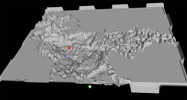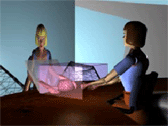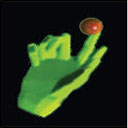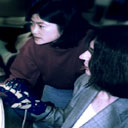Distributed Haptic Environments
In many applications of haptics it will be necessary for users to interact with each other as well as with other objects. We have developed architecture, for haptic collaboration among distributed users. Our focus is on collaboration over a non-dedicated channel (such as an Internet connection) where users experience stochastic, unbounded communication delays Adding haptics to multi-user environments creates additional demand for frequent position sampling for collision detection and fast update. It is also reasonable to assume that in multi-user environments, there may be a heterogeneous assortment of haptic devices (e.g. the PHANToM, the CyberGrasp, the iFeel mouse) with which users interact with the system. One of our primary concerns is thus to ensure proper registration of the disparate devices with the 3D environment and with each other.
 This project addresses the real-time collection and simultaneous broadcast of haptic information to multiple haptic session participants, so that collaborative exploration of objects is possible, even when users are equipped with disparate haptic devices, such as the PHANToM and the CyberGrasp. We are designing and a prototype system for haptic collaboration over the Internet. The basic idea is to provide a framework for multiple users (each with his or her own haptic device connected to a computer) to share a common experience of touch. This will allow users to exert forces on each other through the network as well as exert forces on common objects. The key challenge is the design of an architecture for haptic collaboration via the Internet that explicitly addresses the issue of latency (communication delay), thus providing a foundation for a shared haptic experience among distributed users. With respect to stability, latency is a critical factor that governs whether two users can truly share a common haptic experience.
This project addresses the real-time collection and simultaneous broadcast of haptic information to multiple haptic session participants, so that collaborative exploration of objects is possible, even when users are equipped with disparate haptic devices, such as the PHANToM and the CyberGrasp. We are designing and a prototype system for haptic collaboration over the Internet. The basic idea is to provide a framework for multiple users (each with his or her own haptic device connected to a computer) to share a common experience of touch. This will allow users to exert forces on each other through the network as well as exert forces on common objects. The key challenge is the design of an architecture for haptic collaboration via the Internet that explicitly addresses the issue of latency (communication delay), thus providing a foundation for a shared haptic experience among distributed users. With respect to stability, latency is a critical factor that governs whether two users can truly share a common haptic experience.

In this project, we integrate haptics with a seismic map. The earthquake data we propose to render haptically is of three kinds: (1) a depth map of the Los Angeles basin, showing the underlying bedrock that forms the bottom of the basin; (2) a map of the surface geology of the area, which shows where the mountains are and where the soil is likely to liquefy; (3) a map of the shaking in various parts of the area due to specific earthquake events (e.g., Northridge).
The most interesting map to render haptically is of the third type. The data are available in the form of amplitude of shaking as a function of time. We will render these (suitably scaled) to the tip of the PHANToM (haptic glove device). We will render the first kind of data (depth) by giving the map more deformability in areas of greater depth (so the user can push down further). Consistent with our interest in developing applications of haptics for visually impaired/blind users we are working with IMSC collaborators to incorporate speech recognition into the interface. Thus a user would be able to interact with the map via spoken commands.

A visitor to the Haptic Museum can use these devices locally at a desktop, in kiosk mode, or remotely over the network, retrieving models of the museum objects from our Web site. In our most recent work we have addressed ourselves to haptic collaboration, in which users with the same and even different haptic devices can not only manipulate and explore the same virtual objects over the network, but can also make realistic touch contact with one another. Our mission is to develop device-independent haptic collaboration such that someone from the museum’s curatorial staff can interact with a student in a remote classroom and together they can jointly examine an ancient pot or bronze figure, note its interesting contours and textures, and consider such questions as “What is the mark at the base of the pot?” or “Why does this side have such jagged edges?” 393 In short, haptics can be used to allow museum visitors to explore objects in ways that cannot be permitted in physical museums due to concerns about breakage and deterioration of the object surface.
IMSC's 2001 NSF Report
IMSC's Technology Summary
More Info
White Paper


